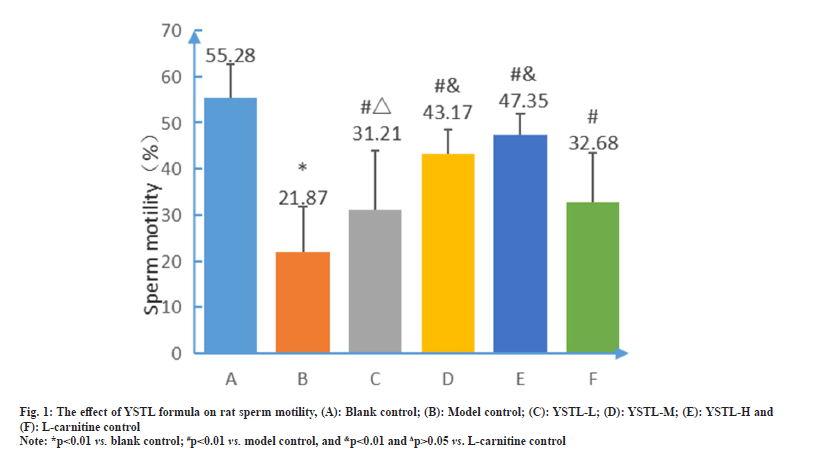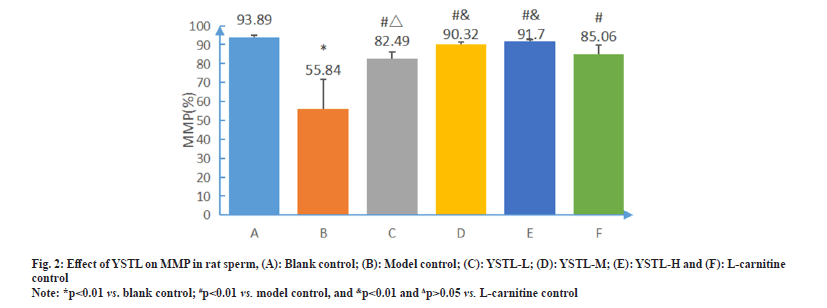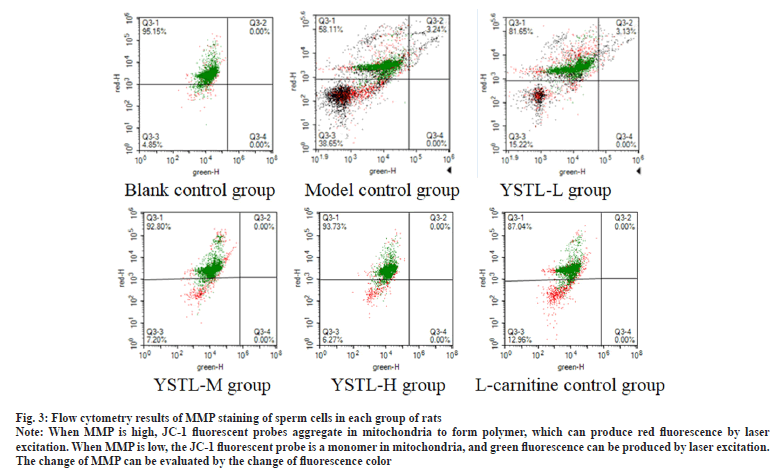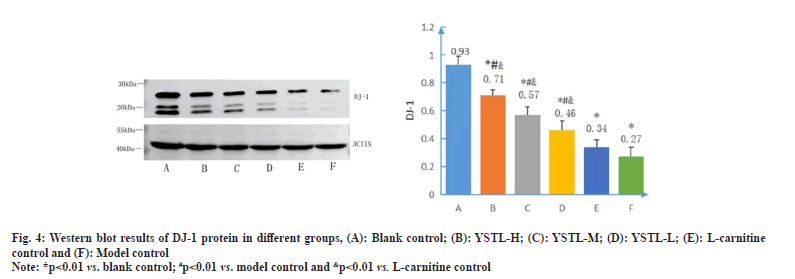- *Corresponding Author:
- G. Z. Qin
Department of Traditional Chinese Medicine, The First Clinical Medical College, Nanjing University of Chinese Medicine, Nanjing, Jiangsu 210023,China
E-mail: qin60@tom.com
| This article was originally published in a special issue, “New Research Outcomes in Drug and Health Sciences” |
| Indian J Pharm Sci 2023:85(6) Spl Issue “169-174” |
This is an open access article distributed under the terms of the Creative Commons Attribution-NonCommercial-ShareAlike 3.0 License, which allows others to remix, tweak, and build upon the work non-commercially, as long as the author is credited and the new creations are licensed under the identical terms
Abstract
The effect of Yishen Tongluo recipe on sperm motility of asthenospermia model rats and its possible mechanisms were studied. 36 Sprague-Dawley male rats were randomized into 6 groups with 6 rats in each group which includes model control group, Yishen Tongluo formula low dose group, Yishen Tongluo formula medium dose group, Yishen Tongluo formula high dose group, levocarnitine control group and blank control group. Ornidazole was used to induce asthenospermia in rats. Sperm motility, mitochondrial membrane potential, protein deglycase DJ-1, reactive oxygen species, malondialdehyde and superoxide dismutase expression levels were quantified. Markedly reduced sperm motility, mitochondrial membrane potential, protein deglycase DJ-1 and superoxide dismutase in model control group vs. blank control group were determined, while reactive oxygen species and malondialdehyde were elevated (p<0.05). In comparison with model control group, low, medium and high dose groups of Yishen Tongluo formula and levocarnitine control group had significantly increased sperm motility, mitochondrial membrane potential, protein deglycase DJ-1 and superoxide dismutase levels, and decreased reactive oxygen species and malondialdehyde levels (p<0.05). Yishen Tongluo formula can effectively improve sperm motility in oligoasthenospermia model rats, possibly by increasing protein deglycase DJ-1 and superoxide dismutase expression, reducing reactive oxygen species and malondialdehyde levels, and protecting mitochondrial function.
Keywords
Oligoasthenospermia, Yishen Tongluo formula, mitochondria, protein deglycase DJ-1, reactive oxygen species
Asthenospermia is a prime reason for male infertility. Currently, it is believed that the occurrence of asthenospermia is closely related to gonad infection, environmental factors, chromosome abnormalities, endocrine abnormalities, varicoceles, trace element deficiency and so on. As an energy center, mitochondria provide energy for sperm activities. If mitochondrial function is abnormal, sperm motility will be decreased[1]. Protein deglycase DJ-1 (DJ-1) is an anti-Oxidative Stress (OS) protein, which can clear intracellular Reactive Oxygen Species (ROS), regulate intracellular mitochondria morphology and function, reduce intracellular ROS generation and play a protective role in cells through its own oxidation[2]. Yishen Tongluo (YSTL) formula is a prescription created by Professor Sun Zixue. Previous studies have found that it can enhance sperm concentration, motility and Deoxyribonucleic Acid (DNA) integrity while reducing OS response. Hence, mitochondria were used as an entry point for research and the mechanism of YSTL formula was preliminarily-investigated in Sprague-Dawley (SD) rats and asthenospermia model was induced by Ornidazole (ORN).
Materials and Methods
Experimental animals:
A total of 36 clean-grade SD rats, all males weighing around 200 g, were provided by Spafas (Beijing) Biotechnology Co., Ltd. (SCXK [Beijing] 2019-0010). Rats were acclimatized for a week before the experiment and then numbered according to their weight before being randomly assigned to six groups. The animals were allowed free access to chow and water, with water changed once a day and bedding changed every 2 d. The environmental temperature was maintained at 20°-25° with a 12 h light/dark cycle. All animal procedures had obtained approval from the Ethics Committee of Henan Provincial Hospital of Traditional Chinese Medicine and registered with the Ethics Committee (Ethics approval number: 92-HNSZYY-2022-024).
Main reagents and drugs:
The YSTL formula contained 20 g Epimedium brevicornum, 20 g Gastrodia elata, 10 g Rehmannia glutinosa, 30 g Salvia miltiorrhiza, 6 g Hirudo nipponica, 10 g Achyranthes bidentata and 20 g Astragalus membranaceus. The formula was decocted into a concentrated solution by Henan Provincial Hospital’s Pharmacy Department, with approximately 4.2 g of crude herbs per ml. Levo (L)-carnitine oral solution (Batch number: H19990372, Northeast Pharmaceutical) and ORN (0.25 g×24 tablets/box, Batch number: H20040375, Tianfang Pharmaceutical Co., Ltd.) were also used. The sperm mitochondrial staining solution was purchased from Shenzhen Boruide Biological Technology Co., Ltd., and the total Superoxide Dismutase (SOD) assay kit (A001- 1), Malondialdehyde (MDA) assay kit (A003-1), Recombinant Anti-beta Actin antibody (GB15003), DJ-1 (GB11640), Horseradish Peroxidase (HRP)- goat anti-rabbit (GB23303), and ROS assay kit (E004-1-1) were supplied by Nanjing Jiancheng Bioengineering Institute. The Polyvinylidene Fluoride (PVDF) membrane (0.45 μm) was purchased from Servicebio (WGPVDF45).
Experimental grouping:
The 36 male SD rats were randomized into six groups with six animals in each group. A model control group was induced with 400 mg/kg/d ORN. The YSTL formula Low-dose (YSTL-L) group received 5.23 g/kg/d of the formula+400 mg/kg/d ORN. The YSTL formula Medium-dose (YSTL-M) group received 10.46 g/kg/d of the formula+400 mg/kg/d ORN. The YSTL formula High-dose (YSTL-H) group received 20.92 g/kg/d of the formula+400 mg/kg/d ORN. The L-carnitine control group received 0.1 g/kg/d L-carnitine+400 mg/kg/d ORN. The blank control group received an equivalent amount of 0.5 % Sodium Carboxymethyl Cellulose (Na CMC) solution via intragastric administration for 4 w.
Sperm motility detection:
After fasting for 24 h following the last administration, the rat is anesthetized and fixed by its limbs. The testis and epididymis are removed, freed from fat and weighed after being rinsed in a culture dish. The testis and epididymis on both sides are removed and crushed to make a sperm suspension. The suspension is incubated in a constant temperature incubator for 30 min before sperm motility detection is carried out.
Mitochondrial Membrane Potential (MMP) detection:
First, motile sperm concentration (106 M/ml) is measured and approximately 1 × 106 spermcontaining semen is selected and allocated into a small glass tube. Add buffer solution to adjust its volume to 0.5 ml. JC-1 fluorescent dye (5 μl) is added under light avoidance conditions and after thorough mixing, it is placed in a light avoidance constant temperature water bath at 37° for 20 min to fully react. The sample is then detected by a flow cytometer.
DJ-1 protein expression:
Western blot method is used to detect DJ-1 protein, and Image J is used for quantitative measurement of protein bands' gray value. The ratio of DJ-1 protein gray value to the internal reference gray value is the relative content of the sample.
SOD, MDA and ROS expr ession:
Cut off a part of the epididymis tissue, weigh it and put it into a glass homogenizer. Add 0.9 % saline solution in a weight ratio of 1:10, and mechanically homogenize it under ice-water bath conditions to make a 10 % epididymis tissue homogenate. Centrifuge it at 3000 rpm for 10 min, take the supernatant, and store it at 4°. The quantification of SOD, MDA and ROS was conducted following the kit recommendations.
Statistical analysis:
Data was collected and summarized through Excel, and the Statistical Package for the Social Sciences (SPSS) software (version 26.0) was used for statistical processing and analysis. T-test is used for metric data (X ͞ ±s), and Chi-square (χ2) test is used for efficacy comparison. Pearson correlation test is used for correlation analysis. Two-tailed tests are used, and p<0.05 is the significance level.
Results and Discussion
Model control rats showed significantly decreased sperm motility than blank control rats (p<0.01), indicating successful establishment of the rat oligoasthenozoospermia model. In comparison with the model control group, the YSTL-L, YSTL-M and YSTL-H and the L-carnitine control group showed varying degrees of recovery in sperm motility (p<0.01). Statistical significance was identified between L-carnitine control group and YSTL-M and YSTL-H groups (p<0.01), but not between L-carnitine control group and YSTL-L group (p>0.05). The results indicate that YSTL formula and L-carnitine oral solution can improve sperm motility, as shown in fig. 1.
As shown in fig. 2 and fig. 3, a significant decrease in the MMP level was determined in model control group vs. blank control group (p<0.01). The treatment groups showed varying degrees of recovery in MMP levels than the model control group (p<0.01). Statistical significance was identified between L-carnitine control group and YSTL-M and YSTL-H groups, but not between L-carnitine control group and YSTL-L group (p<0.05). Thus, ortho (o)-Nitrophenyl (ONP) treatment could decrease the MMP level in rat sperm, while YSTL and L-carnitine oral liquid could stabilize the MMP level.
Fig. 3: Flow cytometry results of MMP staining of sperm cells in each group of rats
Note: When MMP is high, JC-1 fluorescent probes aggregate in mitochondria to form polymer, which can produce red fluorescence by laser
excitation. When MMP is low, the JC-1 fluorescent probe is a monomer in mitochondria, and green fluorescence can be produced by laser excitation.
The change of MMP can be evaluated by the change of fluorescence color
Model control rats showed markedly reduced DJ-1 protein levels than blank control rats (p<0.01). The drug treatment groups showed an increase in DJ-1 protein expression than model control group, especially in the YSTL-L, YSTL-M and YSTL-H (p<0.01). DJ-1 protein expression elevated as the YSTL formula concentration increased. YSTL-L, YSTL-M and YSTL-H showed a significant increase in DJ-1 protein expression than L-carnitine control group (p<0.01) (fig. 4).
Model rats showed evidently elevated epididymis ROS and MDA levels and reduced SOD than blank control rats (p<0.01). While compared to the model group, all treatment groups showed decreased MDA and ROS and increased SOD levels (p<0.05). The higher the dose of YSTL formula then the reduction in MDA and ROS levels is also greater. In addition, YSTL-H and blank control group did not differ significantly in MDA and ROS (p>0.05), indicating that the high-dose YSTL formula had the best antioxidant capacity and could effectively counteract the oxidative damage caused by ORN (Table 1).
| Group | SOD | MDA | ROS |
|---|---|---|---|
| Blank control | 188.70±23.66 | 10.64±1.78 | 27.44±9.87 |
| YSTL-L | 136.0±21.8# | 28.37±15.8# | 100.34±9.63# |
| YSTL-M | 168.82±21.72#Δ | 18.22±7.16# | 47.01±11.4#Δ |
| YSTL-H | 172.2±15.38#Δ | 13.29±3.39#Δ& | 35.84±8.73#Δ& |
| L-carnitine control | 134.70±34.38# | 21.13±6.08# | 75.83±13.89# |
| Model control | 55.35±20.71* | 31.68±6.67* | 119.70±12.36* |
Note: *p<0.01 vs. blank control; #p<0.01 vs. model control; Δp<0.05 vs. L-carnitine control and &p>0.05 vs. blank control
Table 1: Effects of YSTL formula on Sod, Mda and Ros levels in rats
There are many causes of asthenozoospermia, but still its cause in clinical practice is unclear. Mitochondria, as the center of sperm energy, are closely related to sperm motility. On one hand, mitochondrial DNA abnormalities can cause energy production disorders and lead to a series of diseases[3]. On the other hand, mitochondrial DNA is almost unprotected by DNA-binding proteins and is easily damaged. If the proteins encoded by these damaged genes participate in Adenosine Triphosphate (ATP) production, protein abnormalities can occur, leading to the process of oxidative phosphorylation, energy deficiency, and then sperm motility disorders[4]. If ROS is produced excessively and exceeds the antioxidant and redox capacity of sperm, it will cause OS reactions. Excessive ROS can attack the mitochondrial transcription system, cause abnormal protein encoding respiratory chain, affect mitochondrial ATP production, and ultimately affect sperm motility. In addition, excessive ROS can cause lipid peroxidation reactions in the mitochondrial membrane of sperm, cause electron leakage from the inner membrane of mitochondria, cause a decrease in MMP, lead to a decrease in ATP generation efficiency, and ultimately affect sperm motility[5,6]. Therefore, ROS is particularly important for sperm motility. This study also showed that after induction with ORN, the elevation in ROS and oxidative damage resulted in decreased sperm motility in rats.
SOD is the most important antioxidant enzyme in testicular tissue, which can remove and maintain oxygen free radicals in a balanced state in the body. In addition, it can also eliminate harmful substances produced by the body's metabolism and has anti-aging effects. MDA is the end product of lipid peroxidation. SOD activity and MDA level in testicular tissue can reflect the degree of OS damage to the tissue[7]. This study found decreased SOD activity and elevated MDA level in rat testicular tissue after ORN modeling, which is consistent with the research. ORN modeling can simulate the disease state of asthenozoospermia.
The DJ-1 protein is a versatile protein that can protect mitochondria by clearing intracellular ROS through its own oxidation process. Research has shown that the DJ-1 protein can also increase the transcription of antioxidant enzymes such as SOD through the Nuclear factor erythroid 2-related factor 2/Antioxidant Response Element (Nrf2/ ARE) signaling pathway, relieving OS[8,9]. The DJ-1 protein can also activate the Extracellular signal- Regulated Kinase 1/2 (ERK1/2) signaling pathway to enhance the effect of antioxidant stress[10]. Studies have also shown that the DJ-1 protein can bind to mitochondrial complex I, which is necessary to exhibit enzyme activity. Decreased DJ-1 protein is accompanied by reduced complex I enzyme activity, affecting the production of energy[11]. Therefore, there is a strong link between DJ-1 protein and mitochondrial function, and this study demonstrates that the MMP of sperm mitochondria decreases as the DJ-1 protein decreases.
In traditional Chinese medicine, asthenozoospermia is classified as “cold and thin sperm” and is believed to be caused by kidney damage and coldness in the sperm. The basic treatment principle is to warm the kidney and nourish the sperm. Professor Sun Zixue believes that male infertility patients have a long course of disease and are deeply affected. He proposed that kidney deficiency and meridian obstruction are the basic pathogenesis of infertility and formulated the YSTL formula to treat infertility. The formula contains 7 medicinal herbs, which include Epimedium, Xanthoparmelia, as the main herbs, Rehmannia and Salvia as the ministerial herbs, Salvia, Hirudo, and Astragalus as the adjuvant herbs and Achyranthes bidentata as the carrier[12]. Most of these medicines have antioxidant properties. For example, Rehmannia contains catalpol, which has antioxidant properties[13] and Hirudo has a strong blood-activating effect and can also dilate blood vessels and dissolve blood clots[14]. These pharmacological effects are similar to the connotation of “nourishing the kidney and promoting meridian circulation” in traditional Chinese medicine, and may be the mechanism by which the formula improves sperm quality.
In summary, the YSTL formula improves the sperm indicators of rats with asthenozoospermia induced by ORN through the effects of nourishing the kidney, promoting blood circulation, and opening the meridians. The mechanism of action of the formula might be that it increases the expression of DJ-1 protein and SOD, reduces ROS and MDA levels and protects mitochondrial function and thereby improving sperm motility. This provides a theoretical basis for the clinical use of the YSTL formula to treat asthenozoospermia.
Author contributions:
Lipeng Fan and Zixue Sun have contributed equally to this work, designed the research and wrote the first manuscript; Lipeng Fan, Zixue Sun, Jianshe Chen, Gaoli Hao, Chenxi Li, Xuyao Lin, Xiao Wei, Chenming Zhang, Hui Zhang and Guozheng Qin have contributed to conceiving the research and analyzing data; Lipeng Fan, Zixue Sun and Guozheng Qin conducted the analysis and provided guidance for the research and all the authors reviewed and approved the final manuscript.
Funding:
This study was funded by National Natural Science Foundation of China (81974573, 82274536), Henan Province Traditional Chinese Medicine Scientific Research Major Special Project (2022ZYZD09), Second batch of Traditional Chinese Medicine Young Talent Program (Project no: 111044) under the Traditional Chinese Medicine Inheritance and Innovation Talent Project (Zhongjing Project) and The Henan Traditional Chinese Medicine Administration Scientific Research Project (No. 2019ZY2044).
Conflict of interests:
The authors declared no conflict of interests.
References
- Chinese Wang Q, Chen L, Sheng L. Advances in studies on the correlation between sperm mitochondria and male infertility. China Mod Doctor 2017;55(4):160-3.
- Wang H, Liu R, Ji W. Research progress on the role of DJ-1 in improving motor function disorders in Parkinson's disease. Life Sci 2022;2(7):197-202.
- Zhou Y, Yang Y. Research progress on mitochondrial DNA mutations and the occurrence of type 2 diabetes. Chin Med Front 2023;7(1):66-70.
- Zhu Z, Kawai T, Umehara T, Hoque SM, Zeng W, Shimada M. Negative effects of ROS generated during linear sperm motility on gene expression and ATP generation in boar sperm mitochondria. Free Radic Biol Med 2019;141:159-71.
[Crossref] [Google scholar] [PubMed]
- Wang X, Liu Q. Relationship between sperm reactive oxygen species, movement and fertilization. Chin J Androl 2021;35(4):65-8.
- Vatannejad A, Tavilani H, Sadeghi MR, Karimi M, Lakpour N, Amanpour S, et al. Evaluation of the NOX5 protein expression and oxidative stress in sperm from asthenozoospermic men compared to normozoospermic men. J Endocrinol Invest 2019;42(10):1181-9.
[Crossref] [Google scholar] [PubMed]
- Hu Y, Xu Y, Gao J, Chen C, Li J, Ma Q, et al. Pharmacological evaluation and action mechanism of Yishen Shengjing Fang in the treatment of oligoasthenospermia. Chin J Exp Tradit Med Form 2022;28(11):93-101.
- Narasimhan KK, Jayakumar D, Velusamy P, Srinivasan A, Mohan T, Ravi DB, et al. Morinda citrifolia and its active principle scopoletin mitigate protein aggregation and neuronal apoptosis through augmenting the DJ-1/Nrf2/ARE signaling pathway. Oxid Med Cell Longev 2019;2019:1-13.
[Crossref] [Google scholar] [PubMed]
- Wang W, Zhao H, Chen B. DJ-1 protects retinal pericytes against high glucose-induced oxidative stress through the Nrf2 signaling pathway. Sci Rep 2020;10(1):1-13.
[Crossref] [Google scholar] [PubMed]
- Oh SE, Mouradian MM. Cytoprotective mechanisms of DJ-1 against oxidative stress through modulating ERK1/2 and ASK1 signal transduction. Redox Biol 2018;14:211-7.
[Crossref] [Google scholar] [PubMed]
- Ding H, Xu XW, Wang H, Xiao L, Zhao L, Duan GL, et al. DJ‐1 plays an obligatory role in the cardioprotection of delayed hypoxic preconditioning against hypoxia/reoxygenation‐induced oxidative stress through maintaining mitochondrial complex I activity. Cell Biochem Funct 2018;36(3):147-54.
[Crossref] [Google scholar] [PubMed]
- Chen X, Li P. Professor Sun Zixue's experience in the treatment of male infertility. Chin J Tradit Chin Med Res 2021;10(3):75-7.
- Ge Z, Zuo G, Sun Z, Wang X. Research progress on the pharmacological substances of Shu Di Huang. Chin Tradit Herb Drug 2023;35(1):292-302.
- Jiang Q, Wang LN, Liu Q, Yang CM, Zhang YQ. Research progress on processing history evolution, chemical constituents, and pharmacological effects of Hirudo. Zhongguo Zhong Yao Za Zhi 2022;47(21):5806-16.
[Crossref] [Google scholar] [PubMed]








